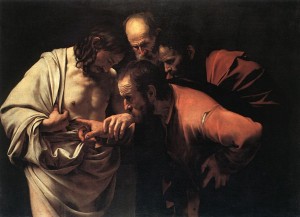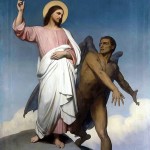“’Now, Bree,’” he said, ‘you poor, proud, frightened Horse, draw near. Nearer still, my son. Do not dare not to dare. Touch me. Smell me. Here are my paws, here is my tail, these are my whiskers. I am a true Beast’” -Aslan, “The Horse and His Boy”
There’s a common misconception in the Christian rank and file that Jesus’ resurrected body was something other than a real, physical body with flesh and bones, and that our resurrected bodies will likewise be something other than or somehow less solid than our bodies are now. Paul’s statement that our bodies will be raised “spiritual” is often cited as proof, as is the fact that Jesus passed through walls after He was raised.
 There are several rebuttals. The first is what N. T. Wright discusses is in his book “Surprised by Hope.” Namely, that Christians have always and everywhere believed in a real resurrection of our real bodies until extremely recently. The “blessed hope” of the Church is enshrined in all of the early creeds: “We believe in the resurrection of the dead, and the life everlasting. Amen.” If this is a misreading of the New Testament, then Christians for almost all of history have had the central fact of biblical eschatology—that we will come bodily back to life on the Last Day—wrong. Christians’ enduring hope has always been what Paul said the creation itself groans for: “the redemption of our bodies.” (Romans 8:23) This is what it means to swallow up death in victory. A “spiritual resurrection” of any kind isn’t resurrection. It’s a euphemistic redescription of death.
There are several rebuttals. The first is what N. T. Wright discusses is in his book “Surprised by Hope.” Namely, that Christians have always and everywhere believed in a real resurrection of our real bodies until extremely recently. The “blessed hope” of the Church is enshrined in all of the early creeds: “We believe in the resurrection of the dead, and the life everlasting. Amen.” If this is a misreading of the New Testament, then Christians for almost all of history have had the central fact of biblical eschatology—that we will come bodily back to life on the Last Day—wrong. Christians’ enduring hope has always been what Paul said the creation itself groans for: “the redemption of our bodies.” (Romans 8:23) This is what it means to swallow up death in victory. A “spiritual resurrection” of any kind isn’t resurrection. It’s a euphemistic redescription of death.
Second, the term “spiritual body” in 1 Corinthians 15:44 does not, in Paul’s original use, mean what the phrase seems to imply in English. Wright points out that to the original audience, a “spiritual body” understood as an “immaterial body” would be a contradiction in terms. There is no such thing. You might as well talk about solid mist or dry water. What Paul is doing, in context, is contrasting a body of flesh (which is the most common New Testament metonym for fallen humanity) with the body of the Spirit—that is, a body empowered and animated by the Holy Spirit. The Jews and Greeks had words for immaterial beings. If Paul had meant for us to expect a non-physical resurrection, he could have spoken of “ghosts,” or “spirits.” He did not. For a man of his background, “resurrection” meant only one thing: To get up out of the grave, body and all, and walk again. Jesus left behind an empty grave devoid of flesh and bones. He took them with Him. And so will we. (1 John 3:2) A physical understanding of our resurrection bodies is crucial to the passage, as Paul calls Christ Himself “a life-giving spirit” in the very next verse. Does this mean the resurrected Christ is a mere spirit? If so, what of the central fact of Christian history? What of the empty tomb? Where did the body go? It got up and walked out, scars and all.
Finally, people will sometimes cite the gospel accounts of Jesus entering through locked doors and walking through walls to visit the Disciples as proof that His body was not quite as solid as it appeared. This is a huge non-sequitur, if you consider it for just a moment. This is God we’re talking about. He had spent His entire ministry in a quite ordinary human body, performing miracles that defied the laws of physics (walking on water, disappearing through crowds, being transfigured and shining like the sun, etc.). No one but the Docetic Gnostics ever suggested that this calls into question the corporeal reality of Jesus’ pre-resurrection body. Why should His miracles after the resurrection prompt us to do so?
Christ’s resurrection body is real and physical and as the Firstborn from the Dead (Colossians 1:18), He guarantees that our resurrection bodies will be, as well. We will sit up and walk out of our graves, leaving nothing behind. The exact properties of this glorified flesh and bone are mysterious, as we would expect of something designed never to die. But it will be real, physical flesh and bone. We will not be ghosts, as the Disciples thought Christ was (until they touched Him). We will be true beasts.
Image: Wikimedia Commons – Le Caravage, L’incrédulité de Saint Thomas












